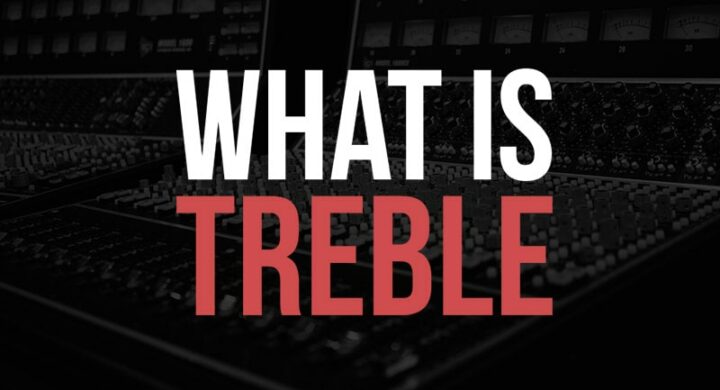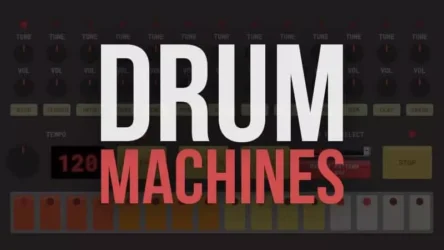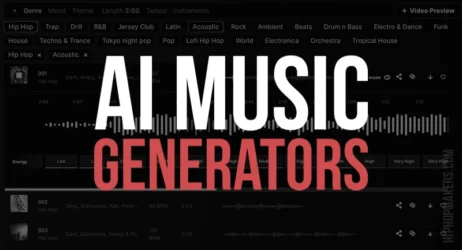This guide will answer what is treble in music, the difference between bass and treble, what treble does, and its common uses.
- What Is Treble In Music
- Difference Between Bass & Treble
- What Does Treble Do
- Treble vs. Mid vs. Bass
- Why Is Treble In Music Important
- What Are The Ideal Treble Settings
- Is Treble The Highest Frequency
- Does Treble Make Voices Clearer
What Is Treble In Music?
Treble is the highest frequency range of sound, it is one of the 3 main ranges in audio, and is often referred to as “high” or “high-end.” Treble is the higher-pitched range of the typical human hearing range, typically from 3 kHz to 10 kHz. It is the highest pitch and has a bright sound.
Treble is what makes a sound clear and lively. Think of what you tend to hear at the beginning of a song, and what part of the music gives you the most energy. Chances are, that sound is treble.
The treble in music is what gives your music life. It is what makes it exciting and interesting to listen to. Treble can be what makes a song sound playful or what turns a lead vocal into the star of the show.

History of Treble
The term treble was first used in the late 13th century to describe the highest vocal range. Back then, bass and treble were the only two vocal ranges.
The history of the treble is what led us to what it is today. Since the 13th century, treble has been evolving and changing in what it can do. As more instruments were added to the music, new ways to use treble were found.
Today the treble is an essential part of music. It can be used to create a range of emotions and feelings in your listener. Music with treble is most likely what we hear at the beginning of a song and what we remember after.
Types Of Treble In Music
There are three types of treble in music:
A vocal treble is what we hear when someone is singing. It is the highest pitch in a vocal range and can be heard in many pop and rock songs.
Instrumental treble is what most people think of when they hear the word “treble” in music. Instrumental treble is what you hear in your traditional gospel choir. It is what gives the music life and what makes it sound exciting.
Electronic treble is what you hear in electronic music. The high pitch is often used to create energy and excitement in the music.
Examples of Treble In Music
There are many examples of treble in music. If you listen to a song and hear what sounds like high-pitched notes ringing, that is treble. Especially if what you hear sounds like bells or whistling, that is what treble in music sounds like.
Listen to the beginning of the song “I Knew You Were Trouble” by Taylor Swift. Notice how high-pitched notes are ringing. That is treble. That sound is what gets you interested in the song.
Now, listen to the beginning of the song “Let It Go” from the movie Frozen. You’ll notice that what sounds like bells ringing is actually the treble in the music. That sound sets the tone for the rest of the song and gives it a playful feeling.
Now, listen to the beginning of the song “Nothing Else Matters” by Metallica. The guitar is playing high-pitched notes and adding treble to the song. This makes the song sound heavier and more intense.
What Is The Difference Between Bass And Treble?
Treble is the highest frequency range of sound in music. It gives instruments like the violin and flute their piercing quality and is also responsible for the clarity of a singer’s voice.
The bass is the lowest frequency range in the sound, which gives instruments like the cello and double bass their deep timbre and makes a singer’s voice rich and full.
Treble is what allows the music to be heard and provides clarity. Without treble, the music is muddled and indistinguishable.
Treble also allows the listener to appreciate what is happening in music. If some instruments are playing more quietly than others, the treble will ensure that the listener still hears what is happening.
Bass is what gives the music its depth and richness. It is what makes the music feel like it is surrounding the listener.
What Does Treble Do?
Treble, also known as high or shrill music, is what most people would refer to as “high-pitched.” The range of sound is higher than what we generally hear in everyday life.
This includes instruments such as trumpets, clarinets, and most other brass instruments. It also includes the majority of woodwinds, such as flutes and saxophones. However, some woodwinds, such as bassoons and contrabassoons, do not usually play in the treble.
The role of the treble is to provide a beautiful, light, and airy sound to the music. It often provides the music with the melody line, accents, and counter melodies.
Treble makes the music in a band or orchestra sound lively and energetic; this can be especially seen when treble contrasts with the bass instruments.
What Is The Difference Between Treble, Mid, & Bass?
Treble is the highest frequency range in sound, while bass is the lowest. Mid is what falls in between, which gives it its unique place in music.
The terms “bass” and “treble” are what people generally think of as the extremes of sound. Bass is what people think of as “low,” while treble is what some are willing to call “high.”
Mid, however, is what comes in between. It can be thought of as what you would call an average singing voice – neither low nor high. Mid-sounds help give the music a sense of balance and make it easier to listen to.
Mid also allows the listener to hear all of what is going on in a piece of music. If the bass is playing a low note while an instrument plays some treble notes in the background, mid will help make sure that the listener hears both.
Why Is Treble In Music Important?
Treble is what makes the music sound beautiful and clear. It allows the listener to appreciate all of the different parts of the music. Without treble, the music would be muddled and indistinguishable.
Treble is also what allows the music to be heard. If some instruments are playing more quietly than others, the treble will ensure that the listener hears what is being played.
Treble also provides a counter-melody to the bass. This gives the music a sense of balance and makes it more interesting to listen to.
What Are The Ideal Treble Settings?
The ideal treble settings will depend on what type of music you listen to. If you listen to classical music, you will want the treble to be set a little higher than if you were listening to rock music.
This is because different types of music call for different types of treble. Classical music often has a lot of high notes, which need to be heard clearly to appreciate the melody.
On the other hand, rock music will have more low notes and not as many high ones. This means that the treble can be set a little softer and will still allow the listener to hear what is happening.
No matter what type of music you listen to, it is essential to make sure that what you are hearing does not sound tinny. While the treble can be set high, it should never be so high that it overpowers the other instruments or becomes unpleasant to listen to.
Is Treble The Highest Frequency?
While the treble is the highest frequency that most people can hear, there are higher frequencies. These are known as ultrasonics and include sounds like a dog whistle or a foghorn.
The highest frequency in sound is what is known as ultrasound. This is used in medical settings to see inside the human body. It is used to make images of a fetus growing in the womb.
Ultrasound has frequencies higher than what we can hear in our ears. This means that it is above the treble range.
While most people cannot hear these frequencies, some animals can still listen to them. Dogs, for example, can hear ultrasound and will often react to it by barking or whining.
Does Treble Make Voices Clearer?
Treble can make voices clearer, depending on what part of the treble range you are talking about. The highest treble ranges are what make voices sound shrill and unpleasant.
However, Treble in what is known as the “mid-range” does make voices more transparent. This is typically used in music and helps ensure that the singer’s voice is heard correctly.
It is essential to ensure they are not set too high when choosing treble settings. This can cause the voice to become shrill and unpleasant to listen to.
Summary of Treble
The treble range is the highest frequency range in sound. It is one of three main audio ranges. The treble range is the highest-pitched range of the human hearing range and is typically between 3 kHz and 10 kHz. With its bright, ringing sound, it is the highest pitch.
In the vibrant world of music, treble refers to the third and highest range of frequencies, offering an essential balance to the deep bass notes and the middle sound spectrum of the mid frequencies. Human ears are tuned to hear higher frequencies, so a well-composed song will ensure sufficient treble to prevent a harsh sound or an ear-piercing effect.
Musical instruments play in different variations across the frequency spectrum, some producing high notes, while others cater to the low-end rumble. High frequencies typically originate from instruments like flutes and violins, whereas low frequencies or bass are from instruments like tubas and bass guitars. Interestingly, the human voice also occupies a significant space in the mid-range frequencies, thus becoming an integral part of the music production process.
The bass and treble frequencies are crucial in many music genres. Hip hop, for instance, tends to favor high bass and sub-bass, creating bigger vibrations in the audio system. In contrast, classical music may emphasize treble sounds, which are created by smaller vibrations and can contribute to a sound system’s overall sound quality. Yet, in any genre, too much bass or lack of treble could make the song sound weak.
In the realm of music production, the equalizer setting plays a pivotal role in striking a balance among treble, mid, and bass frequencies. This balance is essential to prevent certain frequencies from overwhelming others and to ensure a smooth sound from the lowest to the highest range. Music scripture, too, often carefully delineates this balance, keeping in mind the unique abilities of the human ear to perceive different frequencies.
Conclusively, the fascinating interplay of treble, bass, and mid-range frequencies in musical instruments and music production makes each music piece a unique exploration of sound. Whether you’re swaying to the low bass notes of a hip-hop track or appreciating the high notes in a classical composition, the brilliance of music lies in these carefully orchestrated variations. The next time you listen to your favorite track on your sound system, remember the crucial role of treble frequencies in the high end of the music spectrum.
I hope you now have a good understanding of treble and how it applies to music.




